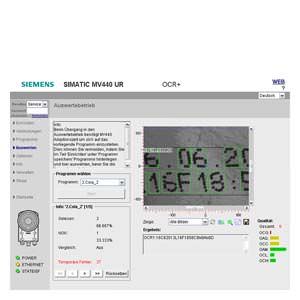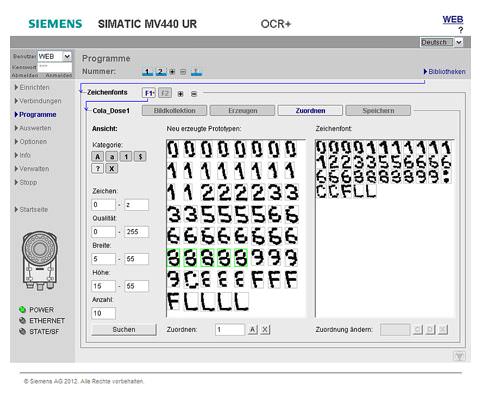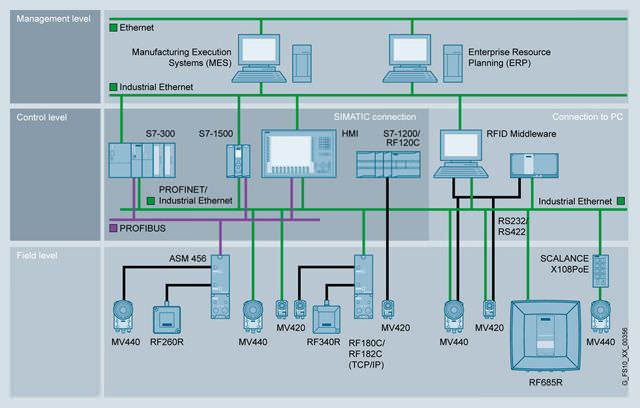Text Genius for SIMATIC MV440 Siemens

Область применения
Applications for text recognition span across almost all sectors. The application areas can be generally divided in three task areas:
- Text recognition for recording the content of a plain text identification.
- Comparison of the content of a plain text identification with the content of the adjacent machine-readable identification, e.g. Data Matrix Code (DMC).
- Comparison of the content of a plain text identification with individually specified values which are transferred to the reader similar to a printer.
Applications for different sectors are listed below. The list is incomplete and only serves to illustrate the wide range of possible applications.
Automotive industry, aerospace industry
- Detection and checking of plain text identifiers for type identification of components
- Comparison of DMC and plain text
- Acquisition of a unique identification of a product (serialization)
- Acquisition and checking the expiry date
Medical equipment
- Laser markings on implants (DPM)
- Laser markings on medical devices (DPM).
Electronics
- Detection of a unique plain text identifier for identifying devices, e.g. electricity meters
- Detection and checking of plain text identifiers for type identification of PCBs
- Solar industry (serial numbers on thin-layer modules)
- Detection of a unique plain text identifier on thin-layer modules (serialization)
Food and beverage industry
- Inspection of expiry date on packaging
- Control of packaging and storage processes
"Text-Genius" and "Text-Genius Plus" can be used anywhere where ambient conditions permit the use of the optical reader SIMATIC MV440. For details, see "SIMATIC MV440". Standard ring lights and lenses are designed to achieve IP67 degree of protection by means of the protective barrel, and for glass-free use in the food and beverages industry. If light sources or lenses are used outside the protective barrel, they must be used in compliance with their specification.
The "text recognition" function can be implemented in applications without the need to consider the type of font used for marking (Polyfont) or the marking method. The fonts which enable a maximum read rate to be achieved are listed in the "Function" chapter. Further fonts and additional characters can be added to Text-Genius Plus at any time by training. No marking methods are excluded either. The read rate improves if the font has a stable appearance and when there is a good contrast between the background and marking.
Обзор
With the "Text-Genius" and "Text-Genius Plus" licenses, SIMATIC MV440 can be used for text recognition (in addition to reading 1D barcodes and 2D matrix codes). Text recognition is also referred to as OCR (Optical Character Recognition). Simultaneous reading and comparing of plain text and reading of machine-readable codes in the same field of view is thus possible.
"Text-Genius" allows text recognition without training for a number of character sets by using generic algorithms, and thus reading without a preparatory phase.

Text-Genius Plus
The "Text-Genius Plus" license comprises all functions of the "Text-Genius" license and additionally enables training of further fonts and characters, including special characters and graphic symbols.
Licenses
The licenses are supplied as a "Single License" on a USB flash drive and can be copied to the device with the SIMATIC Automation License Manager (ALM) using a plug-in. The "Text-Genius" license is executable on a SIMATIC MV440 with firmware version 3.0 and higher, the "Text-Genius Plus" license with Firmware version 5.0 and higher.
Дизайн
All stationary optical SIMATIC MV440 readers are basic units under the terms of the "Text-Genius" and "Text-Genius Plus" licenses. The text recognition functionality is enabled by transferring the license key from the supplied USB flash drive to the MV440 reader by means of SIMATIC License Manager.
The functionality is available without a license in demo mode. The functions subject to licensing are fully available without performance restrictions in Demo mode. Only output of the results on the communication channels is disrupted. Users can therefore determine in Demo mode if the functions and performance fulfill their requirements.
Функции
The outstanding feature of "Text-Genius" and "Text-Genius Plus" is that they are easy to set up. To achieve stable read results for text recognition, it is only necessary to set a few, simple parameters. "Text-Genius" uses a generic approach for text recognition, so no individual training is required for most fonts and the characters (letters and digits) of the ASCII character set. Recognition of several fonts is thus possible with this software without specific training. In particular, no complex settings are required for optimizing recognition performance.
The following fonts are ideal for recognition of the text:
- OCR-A
- Semifont M13
- and similar fonts
Furthermore, Arial, OCR-B and similar fonts also produce good reading results.
"Text-Genius Plus" additionally allows the training of additional characters for any character set. Expansion of the character set is required to allow recognition of characters which are not included or of those which are deformed as a result of the printing process. The character sets of the "Text-Genius" license are available as the basis for text recognition with "Text-Genius Plus", meaning that text recognition can be started immediately without further training. "Text-Genius Plus" is particularly suitable for applications with a varying print image and unknown fonts.
Интеграция
The MV440 text recognition systems can use all communication services that the SIMATIC MV440 basic unit offers:
Usable communication services | |
|---|---|
PROFINET IO (FB79) | Onboard MV440 PROFINET interface. |
PROFINET IO (FB101, Ident profile) | Onboard MV440 PROFINET interface. |
PROFINET IO (FB45, FB101, Ident profile) | Via MV440 communication module interface, using the RF180C communication module. |
PROFIBUS DP V0/1 (FB45, Ident profile) | Via MV440 communication module interface, using the ASM 456 communication module. |
TCP/IP native | Onboard MV440 PROFINET interface. |
RS-232 (ASCII) | Onboard MV440 RS232 interface. |
The most important types of interface in the automation environment are shown in the overview below. For further details, refer to the chapter on SIMATIC MV440.

Особенности

Highlights of Text-Genius and Text-Genius Plus at a glance
- Quick and reliable reading (up to than 2000 readings per minute depending on the application) for high-speed applications.
- Fast and reliable checking of the readability of plain text (up to 1000 reads per minute) for high-speed applications.
- Flexible reading and swapping between different fonts (e.g. OCR A, OCR B) without complex learning using Polyfont character set.
- High reading rate and reliability through saving of fonts on the camera.
- Reading and comparison of plain text and machine-readable code in the same image field.
- Automatic position tracking of the reading range with the resources of "Pat-Genius".
- Automatic text localization without the use of predefined areas means that text can be read even when its position varies.
- Automatic line detection for max. 12 freely definable image regions with max. 15 lines.
- Automatic character height recognition between 15 and 220 pixels.
- Individual parameterization per image region.
- Reading of mirrored, 90° rotated, and inverted text.
- Numerous filter and comparison functions.
- Comparison of text recognition result with an individually specified text per read operation.
- Flexible retrofitting of the text recognition function via the SIMATIC Automation License Manager
- Simple integration in the automation environment, e.g. via function block of the SIMATIC MV440 devices.
Additional highlights of Text-Genius Plus:
- Simple training of additional characters and fonts (user fonts).
- Adaptation of text recognition by user fonts to the specific requirements of the application to enable:
- Expansion of defined fonts by missing characters, e.g. special characters.
- Optimization of recognition for specific printing procedures (e.g. laser, ink, scribed, needled).
- Optimization of recognition by using different versions of individual characters, e.g. to compensate distortions.
- Up to five user fonts can be used in the reader.
- Very high read reliability can be achieved (> 99.5%).







 Ответ от производителя может занять до 5 дней и более.
Ответ от производителя может занять до 5 дней и более.

